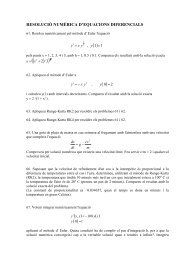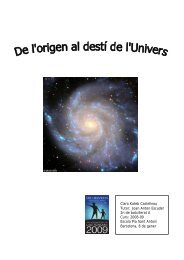Universitat de - Departament d'Astronomia i Meteorologia ...
Universitat de - Departament d'Astronomia i Meteorologia ...
Universitat de - Departament d'Astronomia i Meteorologia ...
Create successful ePaper yourself
Turn your PDF publications into a flip-book with our unique Google optimized e-Paper software.
58 Chapter 2. Multiwavelength approach to LS 5039<br />
Apart from optical photometry in the Johnson filters, Strömgren and Hβ pho-<br />
tometry have also been conducted. Kilkenny & Whittet (1993) reported the fol-<br />
lowing Strömgren photometry for LS 5039: V = y = 11.223 ± 0.014, (b − y) =<br />
0.766 ± 0.008, (v − b) = 0.624 ± 0.010, (u − b) = 1.204 ± 0.014, m1 = −0.142 ± 0.014<br />
and c1 = −0.044 ± 0.022. They also computed the following <strong>de</strong>-re<strong>de</strong>nned val-<br />
ues: V = y = 11.223 ± 0.014, (b − y) = 0.743 ± 0.008, (v − b) = 0.597 ± 0.010,<br />
(u − b) = 1.202 ± 0.014, m1 = −0.146 ± 0.014 and c1 = −0.008 ± 0.022. Finally,<br />
Kilkenny (1993) reports the following Hβ photometry: β = 2.576 ± 0.010.<br />
2.5.2 Spectral type<br />
Kilkenny (1993) was the first one to suggest a spectral type for LS 5039. He classified<br />
it as an O7IV star based on Strömgren and Hβ photometry. Later on, Motch et al.<br />
(1997) took a low resolution λλ 3800–4700 (all λ are expressed in ˚A) spectrum and<br />
a medium resolution red spectrum. Among O stars, those showing N iii in emission<br />
at λλ 4630–34 and He ii strongly in emission at λ 4686 are classified as Of stars.<br />
When the N iii is in emission and the He ii is weakly in absorption or emission they<br />
are classified as O(f). Finally, when the N iii is in emission and the He ii is strongly<br />
in absorption they are classified as O((f)). Motch et al. (1997) reported an O7V<br />
star with well marked He ii λ 4684 absorption and some evi<strong>de</strong>nce for weak N iii<br />
λλ 4634–4642 emission, and therefore suggested an O7V((f)) classification. No Hα<br />
emission was present in their medium resolution red spectrum.<br />
Clark et al. (2001) obtained higher resolution optical and near infrared spectroscopy<br />
of LS 5039. All Balmer lines were in absorption, preventing hence a classification<br />
as an Oe/Be star. The red-end spectrum (λλ 5650–7500) contained interstellar<br />
lines and helium lines in absorption. The blue-end spectrum (λλ 4050–4950)<br />
showed hydrogen Balmer series and He ii lines. The ratio between He ii λ 4541 and<br />
He i λ 4471 correspon<strong>de</strong>d to a spectral type O6.5, while the presence of He ii 4686<br />
strongly in absorption indicated that LS 5039 is still in the main sequence. Finally,<br />
the presence of very weak emission from N iii λλλ 4634–40–42 allowed them to add<br />
the ((f)) classification. Therefore, they classified LS 5039 as an O6.5V((f)) star. Furthermore,<br />
their K band (2.05–2.20 µm) and H band (1.49–1.72 µm) spectroscopy<br />
was perfectly consistent with such classification, and they stated that there was no<br />
evi<strong>de</strong>nce from any additional emission feature that could be attributed to emission<br />
from a jet or accretion disk.






